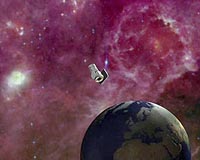 |
Washington DC (SPX) Nov 18, 2009 Astronomers will tie together the largest collection of the world's radio telescopes ever assembled to work as a single observing tool in a project aimed at improving the precision of the reference frame scientists use to measure positions in the sky. The National Science Foundation's Very Long Baseline Array (VLBA) will be a key part of the project. For 24 hours, starting Wednesday, November 18, and ending Thursday, November 19, 35 radio telescopes located on seven continents will observe 243 distant quasars. The quasars, galaxies with supermassive black holes at their cores, are profuse emitters of radio waves, and also are so distant that, despite their actual motions in space, they appear stationary as seen from Earth. This lack of apparent motion makes them ideal celestial landmarks for anchoring a grid system, similar to earthly latitude and longitude, used to mark the positions of celestial objects. Data from all the radio telescopes will be combined to make them work together as a system capable of measuring celestial positions with extremely high precision. The technique used, called very long baseline interferometry (VLBI), has been used for decades for both astronomical and geodetic research. However, no previous position-measuring observation has used as many radio telescopes or observed as many objects in a single session. The previous record was a 23-telescope observation. At a meeting in Brazil last August, the International Astronomical Union adopted a new reference frame for celestial positions that will be used starting on January 1. This new reference frame uses a set of 295 quasars to define positions, much like surveyor's benchmarks in a suburban subdivision. Because even with 35 radio telescopes around the world, there are some gaps in sky coverage, the upcoming observation will observe 243 of the 295. By observing so many quasars in a single observing session, problems of linking positions from one observing session to another can be avoided, the astronomers say. The result will be a much stronger, more precise, reference grid. Telescopes in Asia, Australia, Europe, North America, South America, Antarctica, and in the Pacific will participate. Improving the celestial positional grid will allow astronomers better to pinpoint the locations and measure the motions of objects in the sky. As astronomers increasingly study objects using multiple telescopes observing at different wavelengths, such as visible light, radio, infrared, etc., the improved positional grid will allow more accurate overlaying of the different images. The improved celestial reference frame also strengthens a terrestrial reference frame used for radio-telescope measurements that contribute to geophysical research. The precise geodetic measurements help geophysicists understand phenomena such as plate tectonics, earth tides, and processes that affect our planet's orientation in space. The VLBA is a continent-wide radio telescope system with 10, 240-ton dish antennas ranging from Hawaii to the Virgin Islands. Operated from the National Radio Astronomy Observatory's Pete V. Domenici Science Operations Center in Socorro, New Mexico, the VLBA offers the greatest resolving power, or ability to see fine detail, of any telescope in astronomy. The multi-telescope observation will be accompanied by public-outreach activities in celebration of the International Year of Astronomy. A public web page devoted to the observation will be hosted at Bordeaux Observatory, and some of the participating telescopes will have webcams available. Share This Article With Planet Earth
Related Links Very Long Baseline Array (VLBA) Astronomy News from Skynightly.com
 NASA's Wise Gets Ready To Survey Whole Sky
NASA's Wise Gets Ready To Survey Whole SkyPasadena CA (SPX) Nov 18, 2009 NASA's Wide-field Infrared Survey Explorer, or Wise, is chilled out, sporting a sunshade and getting ready to roll. NASA's newest spacecraft is scheduled to roll to the pad on Friday, Nov. 20, its last stop before launching into space to survey the entire sky in infrared light. Wise is scheduled to launch no earlier than 6:09 a.m. PST (9:09 a.m. EST) on Dec. 9 from Vandenberg Air Force ... read more |
|
| The content herein, unless otherwise known to be public domain, are Copyright 1995-2009 - SpaceDaily. AFP and UPI Wire Stories are copyright Agence France-Presse and United Press International. ESA Portal Reports are copyright European Space Agency. All NASA sourced material is public domain. Additional copyrights may apply in whole or part to other bona fide parties. Advertising does not imply endorsement,agreement or approval of any opinions, statements or information provided by SpaceDaily on any Web page published or hosted by SpaceDaily. Privacy Statement |